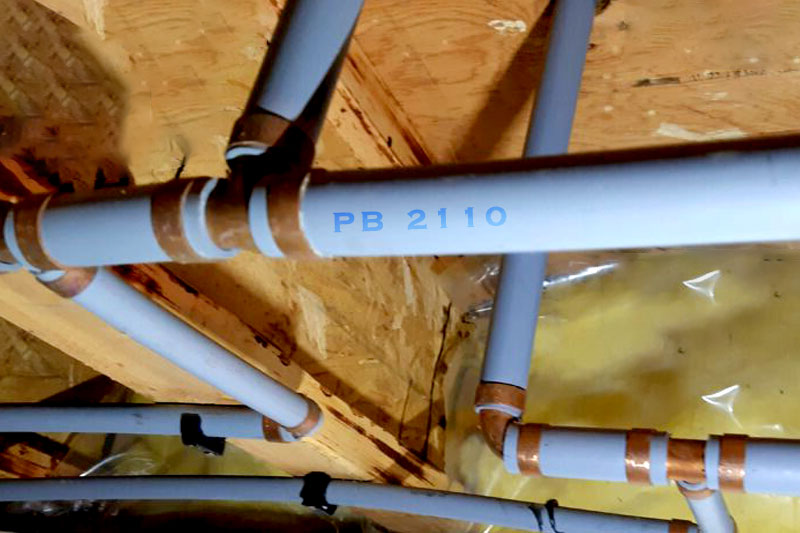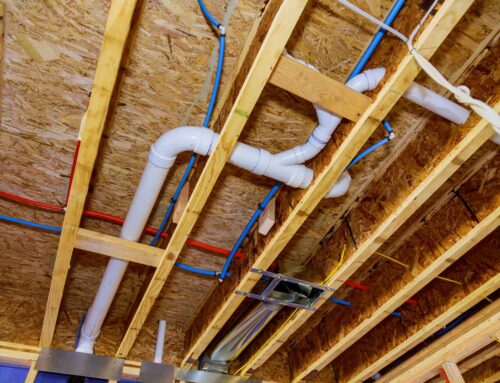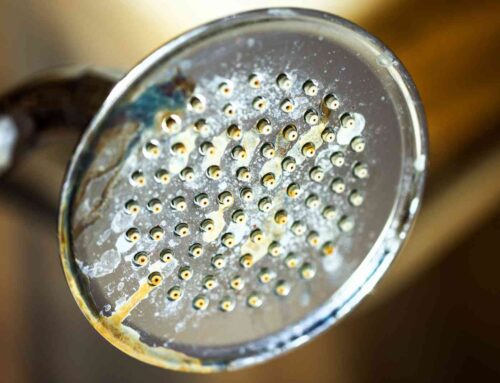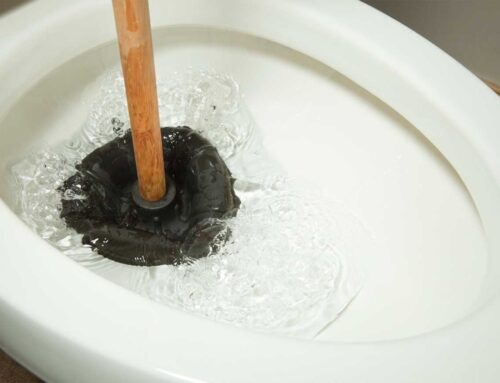Polybutylene pipe is a type of plastic plumbing pipe used for potable water supply in residential and commercial construction. It was widely used from the 1970s through the mid-1990s and it is said to have been installed in as many as 10 million homes when it became increasingly apparent that the piping material was prone to leaking and corrosion. Today, polybutylene pipe is no longer being produced and has been banned by most jurisdictions from being installed in new construction due to its propensity to fail. All homes are needing to be repiped with other pipe material, our preference is to use pex.
What Is Polybutylene Pipe?
Polybutylene pipe (PB) is a type of flexible plastic plumbing pipe that was commonly used in home construction from the 1970s until the mid-1990s. PB pipes were manufactured in ½”, ¾”, 1”, 1¼” and 2” sizes. They were generally gray in color with a smooth finish but could also be black or blue. The pipes were connected using brass crimp rings or copper crimp sleeves and fittings. PB pipes are still found in many homes today but are no longer being produced or allowed to be installed in new construction due to their tendency to leak and corrode over time.
The birth and History of Poly Pipes
Polybutylene is a specific type of plastic material under the wider category of polyolefin. It was first developed in the late 1970s as a low-cost alternative to traditional materials like copper for plumbing systems. Throughout the 1980s and 1990s, PB pipes were installed in millions of homes across North America and Europe, primarily because they were cheaper and easier to install than traditional metal pipes. During this time, poly plumbing pipes were considered to be the “pipe of the future,” thanks to their low cost and quick installation benefits.
Why Does Polybutylene Pipe Fail?
The primary reason why PB pipes failed is that they were not designed for use with hot water systems—which most homes have today—and instead were only suitable for cold water applications. This meant that when hot water ran through the pipes, it caused them to expand and contract which weakened them over time leading to leaks, ruptures and corrosion.
Additionally, many of the fittings used with PB piping were made of brass which can corrode when exposed to high temperatures leading to leaks as well. Lastly, since PB piping was relatively inexpensive compared to other types of plumbing materials such as copper or PEX, many contractors chose to install it even though it wasn’t recommended for use with hot water systems.
Other Common issues and drawbacks
Although PB pipes offer certain advantages, homeowners should be aware of the potential problems associated with polybutylene systems. As mentioned earlier, these pipes are susceptible to oxidative degradation, leading to brittle and weak pipes that may suddenly rupture or develop leaks. This can result in water damage and costly repairs, especially if the issue isn’t addressed in a timely manner.
Another potential issue is that not all plumbers may be familiar with polybutylene systems, making it difficult to get advice or assistance when it comes to maintenance, repairs, or replacements.
Insurance companies may also charge higher premiums to homeowners with PB pipes due to their associated risks, which can impact your wallet and property value in the long run.
How Can You Tell If You Have Polybutylene Piping?
If your home was built between 1975 – 1995 there’s a good chance you may have polybutylene pipework running throughout your house so it’s important to check if you do indeed have it installed. The best way to tell if you have polybutylene pipe is by looking at its exterior; PB pipes are usually gray in color with a smooth finish but can also be black or blue depending on where they were sourced from so look out for those colors first before anything else.
Additionally, look at the fittings that connect two different sections together; if they appear corroded then this is another sign that you may have polybutylene pipework installed in your house since this type of fitting often corrodes when exposed to hot water temperatures over time. Lastly, look for any visible signs of leaks around these fittings as this could indicate an issue with your PB pipework too!
Here is the step-by-step way to identify PB Piping in your Home.
Step 1: Gather the necessary tools and materials
Before searching for polybutylene pipes in your home, gather the necessary tools and materials. This will ensure that you can efficiently inspect your plumbing system. You will need:
– A flashlight
– A tape measure
– A step ladder (if needed)
– A notepad and pen for note-taking
Step 2: Understand polybutylene pipes and their history
Polybutylene is a type of plastic resin that was used in the manufacturing of pipes between 1978 and 1995. These pipes were popular because they were inexpensive, easy to install, and resistant to corrosion. However, they were later found to be prone to breakage and deterioration due to exposure to chemicals found in water, which has led to various lawsuits and settlements. Identifying polybutylene pipes in your home is crucial, as it will help you avoid potential damages and costly repairs.
Step 3: Identify common locations for polybutylene pipes
You are more likely to find polybutylene pipes in specific areas of your home. You should be able to identify polybutylene easily in your piping systems. Some common locations include:
– Main water supply line to your home
– Supply lines to sinks, toilets, and bathtubs/showers
– Pipes in your home’s foundation or crawlspace
– Pipes in your attic or basement
-Near your water heater
-Vent piping or water meter
Step 4: Identifying the color and markings of poly pipe
Polybutylene pipes are typically gray, blue or black in color but can also be found in white. They may be marked with the initials ‘PB’ followed by a series of numbers, which indicate the pipe’s diameter. For example, “PB2110” is a common marking to look for.
Step 5: Inspect visible pipes in your home
Using your flashlight and ladder (if needed), closely examine all visible pipes in your home, focusing on the common locations mentioned earlier. Look for pipes that match the color and markings of polybutylene pipes. Take measurements with your tape measure to confirm the diameter and make notes of any findings in your notepad.
Step 6: Check connections and fittings
Polybutylene pipes are often connected to other pipes using copper fittings or aluminum fittings. Inspect these connections for signs of deterioration, particularly at elbows, T-joints, and shut-off valves. If these fittings also show wear and corrosion or are with plastic, this may further indicate the presence of polybutylene pipes in your home.
Step 7: Consult a professional plumber
If you’ve identified polybutylene pipes or are uncertain about your findings, consult a professional plumber to conduct a thorough inspection of your plumbing system. A licensed plumber will provide expert advice on whether your pipes need replacement and any other necessary remediation work. KBR is the bay area’s polybutylene pipe replacement experts.
Polybutylene Pipes Class Action Lawsuit
When it comes to corporate malfeasance and environmental hazards, few cases have garnered as much attention as the class action lawsuit against Shell Oil Company and polybutylene pipes. This legal battle, which began in the 1990s, shed light on the widespread damage caused by these pipes, which were prone to leakage and caused significant property damage for homeowners.
Cox v. Shell Oil Lawsuit
Many people were unaware that these pipes, made of a type of plastic resin known as polybutylene, had been installed in their homes during construction. The revelation that a reputable company like Shell Oil played a major role in producing and promoting the use of these materials only added fuel to public outrage.
The polybutylene lawsuit ultimately led to a greater awareness of corporate responsibility for environmental issues, as well as increased scrutiny of polybutylene pipes in residential and commercial properties. Despite these lessons learned, it remains vital that society remains vigilant in holding companies accountable for their actions and ensuring that innocent individuals do not bear the brunt of the harm caused by profit-driven decision-making.
Should I Replace Polybutylene Pipes or just repair them?
PB pipes were reported to be highly susceptible to degradation and failure due to several factors, including exposure to chlorine content present in municipal water supplies, oxidants, or water temperature fluctuations. This degradation substantially weakens the pipes from within, making them prone to breakage and leaks, which could result in massive damage to your property.
Now, let’s address the question at hand – should you replace or repair polybutylene plumbing? When deciding between replacement or repairs, one must weigh the advantages and disadvantages, as well as the costs associated with each approach.
First, repairing polybutylene plumbing might seem like a more cost-efficient option in the short term but could prove to be expensive in the long run. Since the core issue lies in the material’s susceptibility to degradation, merely replacing a section of the PB piping may not be an enduring solution. Instead, it may only serve as a temporary fix until other parts of the plumbing system experience the same fate. Additionally, repeated repairs might end up costing more than a complete overhaul and replacement of the plumbing system.
On the other hand, replacing the entire polybutylene plumbing system with a more reliable and durable material, such as PEX (cross-linked polyethylene) or copper piping, can be a significant investment upfront. However, this approach ensures long-term reliability, significantly reducing the likelihood of subsequent pipe failures and leaks. Moreover, modern plumbing materials such as PEX tubing are resistant to corrosion and chemical leaching, and they possess an outstanding ability to withstand temperature variations, making them ideal for diverse water conditions. By opting for a complete replacement, you will not only secure the long-term integrity of your plumbing system but also enhance the overall value of your property.
Investing in a modern, durable plumbing system will substantially reduce the likelihood of plumbing emergencies, future repair costs, and potential damage to your property. Making this crucial upgrade will not only ensure the longevity and integrity of your plumbing system but also grant you peace of mind. You will find important information in our guide for how to prepare for a whole-house repiping.
Will My Homeowners Insurance Cover Polybutylene Pipe Leaks?
Unfortunately, if you own a property with polybutylene plumbing that did not participate in any of the prior polybutylene class-action lawsuits, your legal options for compensation may be quite limited.
Additionally, while homeowners insurance policies generally cover damage resulting from sudden and unexpected incidents like burst pipes, many insurers specifically exclude coverage for problems arising from polybutylene pipes. In these cases, homeowners may have to bear the costs of repairing or replacing the damaged pipes, as well as any related water damage, entirely out of pocket.
In short, the answer is no, your poly pipe leaks or damage will not be covered by your insurance company.
Can I sell my home with Polybutylene Plumbing?
Selling a home with polybutylene piping is certainly possible, but it does come with its unique set of challenges due to concerns associated with this particular type of plumbing material. Polybutylene pipes were widely used in residential construction from the late 1970s to the mid-1990s for their affordability and ease of installation. However, as time has passed and more research has been conducted, it has become apparent that this material is less durable than initially thought and prone to leaks, which may result from degradation or internal scaling. This raises red flags for potential buyers and insurers alike, as the possibility of costly damage due to water leaks and pipe replacement becomes more prevalent.
Despite these concerns, selling a home with polybutylene piping is not impossible. Proper disclosure of the existing plumbing system is critical, as honesty and transparency can alleviate certain apprehensions from prospective buyers. Moreover, conducting a thorough inspection by a certified professional and addressing any current issues can demonstrate a commitment to maintaining the home’s integrity. Additionally, being open to negotiation on the sale price or potentially offering a credit for future pipe replacement may appeal to buyers who might otherwise be hesitant due to the presence of polybutylene piping.
Ultimately, while the presence of polybutylene pipes in your home might limit the pool of interested buyers and affect the final sale price, being proactive in addressing any concerns and forthrightly communicating the situation can still lead to a successful sale. We’ve seen sales fall through because of poly piping.
Finding polybutylene pipes in your home plumbing systems is essential to prevent potential damages and costly repairs. By following these step-by-step instructions, you will be better equipped to inspect your home’s plumbing system and take appropriate action if polybutylene pipes are present.
In conclusion, polybutylene pipe (PB) is a type of plastic plumbing pipe that was widely used during the 1970s – 1990s in residential homes until it became apparent that it tended to leak and corrosion due its design not being suitable for hot water systems like what most homes now have today. As such, it has been banned by most jurisdictions from being installed in new construction although some older homes may still contain this type of pipework so it’s important to check if yours does indeed contain any by looking at its exterior color & fittings as well as any visible signs of leaks around them too! Doing so will help ensure your house remains safe & sound for years ahead!
Call KBR for a free consult in person or by video.






